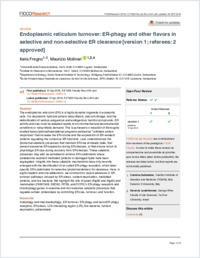Endoplasmic reticulum turnover : ER-phagy and other flavors in selective and non-selective ER clearance
- Fregno, Ilaria Institute for Research in Biomedicine (IRB), Faculty of Biomedical Sciences, Università della Svizzera italiana, Switzerland - Department of Biology, Swiss Federal Institute of Technology, Wolfgang-Pauli-Strasse 27, CH-8093 Zurich, Switzerland
- Molinari, Maurizio Institute for Research in Biomedicine (IRB), Faculty of Biomedical Sciences, Università della Svizzera italiana, Switzerland - École Polytechnique Fédérale de Lausanne, School of Life Sciences, EPFL Station 19, CH-1015 Lausanne, Switzerland
-
13.04.2018
Published in:
- F1000Research. - 2018, vol. 7, p. 454
Autophagy and macroautophagy
ER turnover
ER-phagy and recovER-phagy receptors
ER stress
LC3-interacting region (LIR)
Live bacteria
Nutrient deprivation
Proteostasis
English
The endoplasmic reticulum (ER) is a highly dynamic organelle in eukaryotic cells. It is deputed to lipid and protein biosynthesis, calcium storage, and the detoxification of various exogenous and endogenous harmful compounds. ER activity and size must be adapted rapidly to environmental and developmental conditions or biosynthetic demand. This is achieved on induction of thoroughly studied transcriptional/translational programs defined as “unfolded protein responses” that increase the ER volume and the expression of ER- resident proteins regulating the numerous ER functions. Less understood are the lysosomal catabolic processes that maintain ER size at steady state, that prevent excessive ER expansion during ER stresses, or that ensure return to physiologic ER size during recovery from ER stresses. These catabolic processes may also be activated to remove ER subdomains where proteasome-resistant misfolded proteins or damaged lipids have been segregated. Insights into these catabolic mechanisms have only recently emerged with the identification of so-called ER-phagy receptors, which label specific ER subdomains for selective lysosomal delivery for clearance. Here, in eight chapters and one addendum, we comment on recent advances in ER turnover pathways induced by ER stress, nutrient deprivation, misfolded proteins, and live bacteria. We highlight the role of yeast (Atg39 and Atg40) and mammalian (FAM134B, SEC62, RTN3, and CCPG1) ER-phagy receptors and of autophagy genes in selective and non-selective catabolic processes that regulate cellular proteostasis by controlling ER size, turnover, and function.
- Language
-
- English
- Classification
- Medicine
- License
- Open access status
- gold
- Identifiers
-
- RERO DOC 326732
- DOI 10.12688/f1000research.13968.1
- ARK ark:/12658/srd1318937
- Persistent URL
- https://n2t.net/ark:/12658/srd1318937
Statistics
Document views: 194
File downloads:
- Texte intégral: 253
